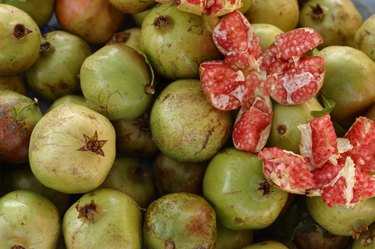
Pomegranate (Punica granatum) is hardy in U.S. Department of Agriculture plant hardiness zones 8 through 11. The tree has its best fruit production in dry, warm conditions. Its variety, fertilization amounts and climate all make a difference in the number of pomegranates it produces. Maximizing those conditions to encourage more fruit can boost your pomegranate's harvest.
Peak Production
Video of the Day
Pruning while the tree is dormant encourages new growth, on which fruit is produced. Wait until the tree is 3 or 4 years old for it to begin fruit production. If everything is optimized for fruit production on your pomegranate tree and it is a mature specimen, you may harvest more than 300 pounds of fruit from it each year.
Video of the Day
Fruit Set
Fruit set is critical for maximizing the yield from your pomegranate tree. Not every flower on the plant sets fruit. Pomegranates are self-fruitful, but cross-pollinating the flowers of one pomegranate with another pomegranate can increase the fruit production of both trees. Bagged flowers that self-pollinated led to 45 percent fruit set while cross-pollination resulted in 68 percent fruit set, according to "Fruits of Warm Climates" by Julia F. Morton. Water also plays an important role in fruit set. In a humid environment, the pomegranate's moisture-sensitive flowers are less likely to set fruit, and any fruit produced in moist conditions is softer and may split.
Fruit Drop
After fruit set, a pomegranate may drop a large number of fruits. That is a normal part of the tree's thinning out process, and it is more likely to happen on a pomegranate that is 3 to 5 years old than an older tree. Too much fertilizer or too much water also can increase the number of fruits the plant drops.
Variety
The pomegranate cultivar you grow plays a role in its fruit production. Not every cultivar is as fruitful as "Wonderful," "Francis" or "Early Wonderful." "King" is one type that produces relatively few fruits in its bush form. Some pomegranate varieties produce flowers but rarely fruit. These include "Chico" and "Legrellei," which both have double flowers but are grown as ornamental trees, not fruit trees.
Fertilization
The amount of fertilizer used can determine whether or not a pomegranate produces more vegetation or fruits. A young tree that has not fruited yet should be given about 2 to 2 1/2 pounds of 8-8-8 in March and November. An older, fruiting pomegranate should receive 4 1/2 to 6 1/2 pounds of 8-8-8 in March and November. Too much fertilizer may cause a pomegranate's fruits not to mature or to have fewer fruits or fruits of less quality. If you notice any of these factors, reduce the amount of fertilizer you give the pomegranate. In Western U.S. states, a mature tree usually does not need fertilizer, just an annual, organic mulch application to provide the plant with the nitrogen it needs; during its early, non-fruiting years, however, it needs 2 to 4 ounces of nitrogen fertilizer.